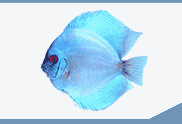

 |
||||||||||||
 |
||||||||||||
| Gill and Skin Flukes | ||||||
| Ardan Huck | May 25, 2002 | |||||
The pictures below were used with permission from "Handbook of Fish Diseases" by TFH Publications, Inc. Flukes are a parasite. There are two main families of flukes affecting discus.  Photo 1: A close up of a Gyrodactylidea family of flukes.
Photo 1: A close up of a Gyrodactylidea family of flukes.
Gyrodactylidea is a fluke which usually attacks the skin. It reproduces with live offspring (no egg). It can have up to four live embryos total, each embryo can have another embryo in it. Thus four generations can be in one parent! Reproduction rates are very fast. Signs of them are small open areas on the skin which can lead to secondary bacterial or fungal infections. They can be as long as .9 mm.  Photo 2: A close up of a Dactylogyridea famile of flukes.
Photo 2: A close up of a Dactylogyridea famile of flukes.
Dactylogyridea family of Flukes is an egg laying fluke and live mainly on the gills. They can be as long as 2 mm. Egg development can take from several hours to four days (according to Untergasser). Eggs can fall to the bottom of the aquarium, once hatches the fluke can swim toward the fish, as it has small eyespots to see the fish as a shadow. Small hooks on the fluke help it attach to the fish. Signs of Fluke infestation include scratching against objects by the fish, rapid breathing due to loss of use of part of a gill, or even holding a gill shut and not using it. Adult fish can usually tolerate a minor infestation of flukes, but if a fish is stressed or weakened the flukes start to overtake the fish. more ... |
 |
|||||
| About Us :: Message Board :: Chat | |||||
| Library :: Photo Gallery :: Links & Resources :: Breeders & Sponsors :: Merchandise | |||||
| Website designed by: EthanCote.com | © 2001-2004, SimplyDiscus.com. All Rights Reserved. | ||||